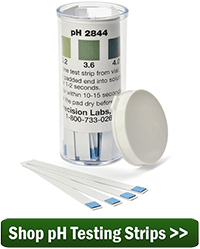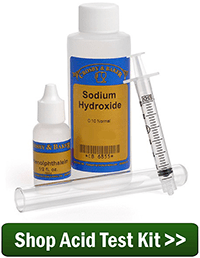 This will be my 3rd season of making wine. I have had some that were excellent and some that weren’t. I have not done anything with acid testing wine. I believe if I do I will have more consistency. Can u explain in more detail the timing and amounts of acid testing. I have purchased the pH test strips to start with. I have read previous blogs and that has not given me enough info.
This will be my 3rd season of making wine. I have had some that were excellent and some that weren’t. I have not done anything with acid testing wine. I believe if I do I will have more consistency. Can u explain in more detail the timing and amounts of acid testing. I have purchased the pH test strips to start with. I have read previous blogs and that has not given me enough info.
Name: Jon
State: Wisconsin
—–
Hello Jon,
You will want to use the pH test strips to verify that the wine must is in the right range before starting the fermentation. When acid testing wine at this time you should expect a reading of 3.2. to 4.0 on the pH scale. If you are following a wine recipe this will normally be the case. A proper acid pH range is important for having a sound fermentation and to protect the wine from the growth of unwanted microbes.
If your wine is not in this pH range then you should make adjustments: either add water to lower the acidity or Acid Blend to raise the acidity. Remember: the pH scale work backwards – the lower the number the higher the acid. If your acid level is extremely high you may want to use more drastic measure such as adding Acid Reducing Crystals in the fermentation instead of dilution with water, but it would be unusual to have to go that far.
You should also acid testing the wine, again, before bottling. The acidity level will almost always change slightly during a fermentation, so expect a different pH reading than from before. From a taste perspective you would like the wine to be somewhere around 3.6, but the optimal reading can be different for each wine depending on the character of the wine.
Before making any adjustments such as adding more Acid Blend, etc., taste the wine and make an evaluation yourself. Acidity has to do with the tartness of the wine as well as its stability. Is the wine too tart or too flat – regardless of what the pH strips say? The whole goal is to get it the way you like it.
You may also want to consider using a Acid Titration Kit at this stage for acid testing wine. It is easy to use and is quite helpful to take a titration reading at bottling time. A titration reads the actual strength of the acid in the wine, not the amount of acid like the pH test strips. The amount and strength of the acids do not directly correlated because some acids are stronger than others, and any wine has a mixture of acids varies from one wine to the next.
So, A titration reading relates to taste, whereas pH is more related to how many acid molecules there are in a sample of the wine. Different acids have different strengths or tartness, so you could have two wine’s with the same pH but with different perceived level of tartness. You can read more about the relation of these two readings in, In Plain English: The Difference Between pH And Titratable Acidity In Wine.
I would also suggest taking a look at an article on our website titled, Getting A Handle On Wine Acidity. It goes into more detail on acid testing wine and how to actually control the acidity
Happy Winemaking,
Ed Kraus
—–
Ed Kraus is a 3rd generation home brewer/winemaker and has been an owner of E. C. Kraus since 1999. He has been helping individuals make better wine and beer for over 25 years.

I have a friend who is making mulberry wine, his Ph is 5.8. I said I would ask you guys and he can see for himself.I suggest to add some tartaric acid.He is making 15 gal. Please answer asap thank you
Doyle bee, your friends pH is way off. It’s off enough to make me wonder if the reading is accurate. If the wine is done fermenting or not yet started fermenting, what needs to happen is to take a gallon of the wine, and add measured amounts of Acid Blend to it until you get a reasonable pH reading: 3.8 to 3.4. Once you have established a dosage, do the same to the other 14 gallons. Preferably you can do this before the fermentation has started, but if it is already fermenting, do nothing until the fermentation has completed and CO2 gas has been removed.
Just read about this acidity stuff. My husband and I are in our first batch of winemaking and only used juice, sugar and yeast proportions. It’s been nearly a month and our taste test showed us it wasn’t what it should be. The friend who had inspired us said to add sugar and some lemon juice. But said nothing about acidity or ph stuff. We do have a hot tub…..can we use one of those test strips in the wine to check on the acidity and ph???
Dorothy, unfortunately you cannot use the pH strips used to test the water in you hot tub to test the acidity of the wine. The buffering on those test strips is different, they are not sensitive enough to get a correct reading.
We live in PA. mostly we make PA grapes into wine. I had heard that our grapes are high in acid, and to cold stabilize the wine outside during the winter. Does this work for the acid adjustment?
Bill, cold stabilizing the wine does help excess acid to drop out of the wine. For more information on this subject, please see the article link posted below.
Cold Stabilization
https://blog.eckraus.com/what-is-cold-stabilization-in-wine-making
This is the first time I’ve tried making wine. I failed to add the wine tannin to the must. Can the wine tannin be added to the juice when I syphon it off to the glass secondary? if not can it be added before bottling.